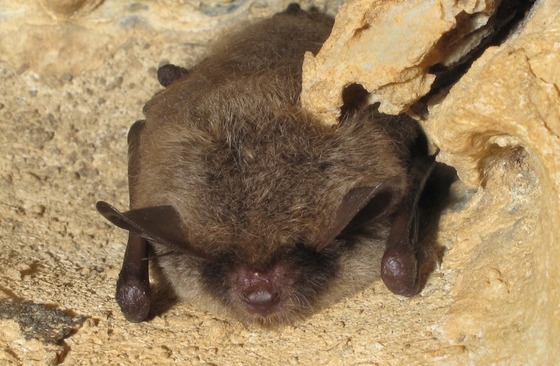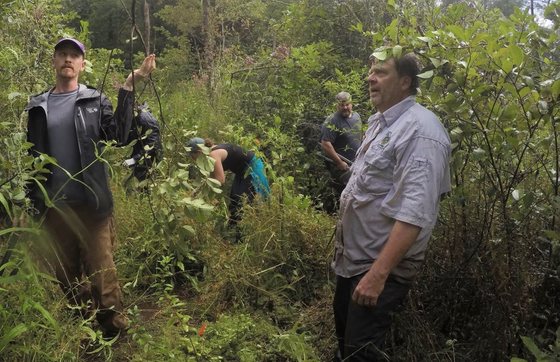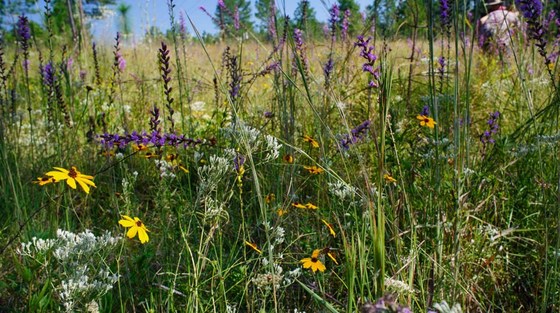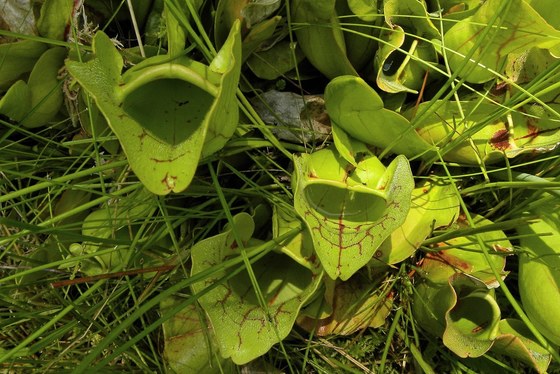IN THIS ISSUE
- Georgia fishes on Flickr
- Teamwork to restore bogs
- Pitcherplants and their prey
 Little brown bat (Alan Cressler)
Want to know about Georgia’s bats, massive flocks of migrating chimney swifts or the conservation focus of Vidalia tree farmer Reese Thompson?
You’ve come to the right place. Watch:
Plus, a bonus: DNR Wildlife Resources Division's response to Hurricane Matthew.
Back to top.
 Spotted sucker on the Yellow River (Brett Albanese/DNR)
Here’s one way to get hooked on Georgia fishes: Check out the new Fishes of Georgia Photo Gallery.
The gallery is geared toward helping the public identify species found in Georgia and better appreciate their unique appearance and sometimes stunning beauty.
The site is a work in progress. The aim is to provide photos of freshwater species – breeding, non-breeding and juvenile color patterns where appropriate – and some commonly encountered marine fishes, from mobile logperch to southern flounder.
Pictures are grouped by fish family and can be searched by common name, genus, species or full scientific name. Descriptions offer details, such as where the fish was photographed and the sex and size, if known. They also spell out the acceptable use. Most photos are available for educational use, with credit for the photographer.
And of course, Flickr offers a free app for IOS and Android that make viewing Fishes of Georgia on your smart phone easy and fun.
Back to top.
 GPCA mountain bog work day with the Bog Learning Network (Rebecca Byrd/DNR)
By EMILY FERRALL
Mountain bogs feature some of the most endangered plant communities in Georgia. These sites, usually about a half-acre to 5 acres, provide habitat for rare species such as swamp pink and purple mountain pitcherplant and rare animals such as the federally listed bog turtle.
Restoring mountain bogs is a complex and challenging task that requires many steps and partners. The work includes removing invasive species to reduce competition with native plants, planting native bog species to augment imperiled populations and “tinkering” with the hydrology to give these obligate wetland species the best chance to survive.
That complexity and those partnerships were in full view weeks ago when members of the Bog Learning Network joined a Georgia Plant Conservation Alliance crew for a work day. This super squad of 19 people teamed to manage invasive species and conduct monitoring at a north Georgia bog.
The day provided a snapshot of what the Bog Learning Network is about.
Made up of more than 60 people across the Southeast, the network brings land managers and scientists together to learn from each other what works or doesn’t in managing bogs. Megan Sutton of The Nature Conservancy and Gary Peeples of the U.S. Fish and Wildlife Service started the group in 2012. Goals include sharing information, advancing outreach and empowering others to do restoration projects.
In Georgia, mountain bog restoration is directed by the Georgia Plant Conservation Alliance, a group of 40-plus members that vary from DNR and the U.S. Forest Service to Zoo Atlanta and Atlanta Botanical Garden and the State Botanical Garden of Georgia.
Interested in the Bog Learning Network, including helping with work days? Email mtns_volunteers@tnc.org. Emily Ferrall is a seasonal staff member with DNR’s Nongame Conservation Section.
Back to top.
 Wildflowers at a Coastal Plain bog (Jay Noe)
BOTANICAL UPDATES
Plant conservationists varying from government botanists to private land managers are gathering at Atlanta Botanical Garden today through Thursday for the Southeastern Partners in Plant Conservation conference. The focus is two-fold: Inform participants on best practices and rare-plant conservation, and form a resources network to support efforts for at-risk and listed species in the Southeast.
The Georgia Botanical Society brought its Year of the Bog celebration full circle with pitcherplant bog restoration work days Oct. 1-2 in southeast Georgia. Volunteers cut back woody shrubs from around Coastal Plain purple pitcherplants and sweet pitcherplants. Without natural disturbances such as fire, pitcherplant bogs become congested with shrubs and trees, choking out pitcherplants and their wildflower associates. (Also see: "Rare jewels," April 19.)
Pitcherplants beguile bugs and humans. Read about some of the
species found in Georgia and how they lure small animals to their
death in the new blog post "Sinister seduction: pitcherplants and their prey" by DNR botanist Lisa Kruse.
At the Georgia Plant Conservation Alliance’s fall meeting recently, DNR Wildlife Resources Division Director Rusty Garrison celebrated the alliance’s conservation contributions and the special recognition award it received in September from the Association of Fish and Wildlife Agencies.
 Mountain purple pitcherplant (Linda May/DNR)
Back to top.
They’re back! The bald eagle pair made famous by Berry College’s nest cams are sprucing up their nest on the northwest Georgia campus. Stay tuned at www.georgiawildlife.com and on Berry’s pages as another nesting season begins.
Drought in north and central Georgia led to a campfire ban at many wildlife managements. The move to reduce wildfire risks is consistent with policy on national forest lands and has the Georgia Forestry Commission’s support.
Floyd County third-graders recently helped stock nearly 3,800 fingerling lake sturgeon in northwest Georgia rivers. The fish, raised at DNR’s Summerville Hatchery, are part of a continuing effort to restore the species to its native waters.
Your thoughts are wanted on how best to create, restore and maintain natural habitats in the 143,000-acre foothills portion of the Chattahoochee National Forest. The Forest Service’s Foothills Project is engaging the public in person and online at http://tinyurl.com/FoothillsLandscapeCollaborate.
 Endangered shinyrayed pocketbook (Jason Wisniewski/DNR)
“Growing up, I couldn’t have told you much about mussels besides the fact that people eat them. …” Follow Nongame Conservation Section staff member Emily Ferrall as she describes her “eye-opening” experience sampling for freshwater mussels.
The Georgia Department of Transportation has earned a national pollinator award for its part in installing a pollinator garden at the Interstate 85 welcome center near West Point. Partners in the Sept. 17 project included the Ray C. Anderson Foundation, Georgia Conservancy, Chattahoochee Nature Center and more than 120 volunteers from Kia Motors Manufacturing Georgia in Troup County.
Names in the news: Gov. Nathan Deal has appointed former Corrections Department Commissioner Homer Bryson as director of the Georgia Emergency Management and Homeland Security Agency. Bryson also previously served as a DNR deputy commissioner and as a colonel in charge of what is now the agency's Law Enforcement Division. Tallulah Gorge State Park Manager Danny Tatum was named Manager of the Year during the State Park Managers Conference. George Dusenbury IV, a former Atlanta Parks & Recreation commissioner, is the Trust for Public Land's new Georgia director, replacing Curt Soper, who now leads the Chelan-Douglas Land Trust in Washington state. Nick Wiley, executive director of the Florida Fish and Wildlife Conservation Commission, has been elected president of the Association of Fish and Wildlife Agencies.
Back to top.
COMING UP
Nov. 1-3 – Southeastern Partners in Plant Conservation, Atlanta Botanical Garden
Nov. 1-4 – 2016 Biennial Longleaf Conference, The Longleaf Alliance, Savannah
Nov. 10 – DNR Fall Field Day focused on quail habitat restoration at Chickasawhatchee WMA, Albany. Spaces are limited. To register, contact Brad Alexander, 229.495.6529 or brad.alexander@dnr.ga.gov.
Nov.18-20 -- Advanced Training for Environmental Education (Core Course 1), Charlie Elliott Wildlife Center, Mansfield
Jan. 27-28 – Weekend for Wildlife (annual DNR nongame fundraiser), The Cloister, Sea Island
WHAT YOU MISSED
In the last Georgia Wild:
- South Georgia’s hard-shelled giants.
- What’s to like about sweetgum trees.
- Rare glimpses of Florida pine snakes.
Back to top.
"Wildlife experts urge gardeners to grow native," Atlanta Journal-Constitution
"Keep feeders hanging for winter hummingbirds," Albany Herald
"Atlanta Botanical Garden to welcome experts for regional plant conservation summit," Broadwayworld.com
"‘First, do no harm’ with seismic blasting," The (N.C.) News & Observer
"Wildlife in decline: Earth's vertebrates fall 58 percent in past four decades," Nature
"Sand dunes important for coastal hurricane protection," The News
"Elk spotted in South Carolina for the first time since the 1700s," The Christian Science Monitor
"Why trees shed their leaves in the fall," EarthSky
"Thank you for quick recovery on Jekyll Island," The News
AUDIO
"Where birds go to die," BirdNote
Back to top.
 To help conserve Georgia's rare species and the natural habitats they need:
-
Buy or renew an eagle or hummingbird license plate. These tags support DNR’s Nongame Conservation Section, which depends largely on such fundraisers to conserve rare and other species not legally hunted or fish for and their habitats.
-
Consider supporting Recovering America’s Wildlife Act of 2016, federal legislation that would provide critical funding for states to conserve wildlife species that need it most. Read the report that led to this legislation.
-
Get out! Fall is prime time to enjoy Georgia’s outdoors and see animals, plants and places that need your help to conserve them for future generations.
Back to top.
Masthead image: Mobile logperch, Coosawattee River (Brett Albanese/DNR)
|